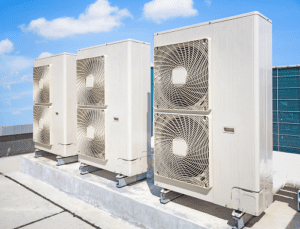New HVAC technology is changing the game for eco-friendly building design and operation. In a previous post, we discussed how air conditioning was contributing to climate change but noted that evolutions in technology were starting to shift that narrative. Across the HVAC industry, manufacturers are committing themselves to developing more eco-friendly products. The reason for the shift isn’t difficult to see. Not only is climate change a threat to the planet as a whole, but consumers—particularly millennials—have made it clear that they care about sustainability and are willing to change their buying habits to benefit the environment. The HVAC industry certainly isn’t the only market that will be impacted by this shift in consumer mindset, but it is undoubtedly one of the industries where a change in approach could have the most significant impact on climate change in general.
New HVAC Technology and the Environment
 One thing that is important to understand right now is that eco-friendly HVAC technology is a work in progress. As more leading manufacturers in the HVAC industry invest heavily in research and development aimed at sustainability, new technologies will crop up, and the current ones will improve. As things stand right now, though, here are some examples of new HVAC technology that could have a positive impact on the environment at large:
One thing that is important to understand right now is that eco-friendly HVAC technology is a work in progress. As more leading manufacturers in the HVAC industry invest heavily in research and development aimed at sustainability, new technologies will crop up, and the current ones will improve. As things stand right now, though, here are some examples of new HVAC technology that could have a positive impact on the environment at large:
- Geothermal heat pumps. While not necessarily new, geothermal technology is becoming more popular in the HVAC industry as the push for more sustainable products continues to grow. Instead of producing heat through gas or electricity, geothermal heat pumps using piping systems installed in the ground to absorb and harvest heat from the earth itself. Depending on the system you are using, a geothermal heat pump can be four times more efficient than the average furnace. Another benefit is that geothermal heat pumps can also be used for cooling or even as water heaters.
- Automation and smart home technology. One of the biggest drivers of energy efficiency boosts in HVAC right now has nothing to do with furnaces, air conditioners, or HVAC systems themselves. The rise of automation and smart home technology has enabled homeowners and business owners to be more strategic with how they are using or preserving heating and cooling in their buildings. Again, this type of technology is not necessarily brand new: smart thermostats, which enable easy programming and temperature shifts throughout the day/week, have been around for years and are a small but effective way to make the most of your heating or cooling. As smart home technology continues to become more commonplace, though, the benefits of this basic type of automation are only going to grow. It’s now easy to adjust thermostat temperatures remotely, automate blinds or curtains to minimize the effect of direct sunlight on interior temperatures, and more. These automated functions can do a surprising amount to help your HVAC system operate more efficiently.
- Ice-powered air conditioners. Most air conditioners use refrigerant or water to create cool air. Why not ice? These air conditioners essentially work by freezing large amounts of water—usually during the night—and then blows air across the melting ice to create a cooling effect. This type of system is relatively new at this point and is only really being manufactured by one brand. If results prove positive, though, expect to see ice used as a more renewable and less environmentally damaging alternative to refrigerant.
- Motion-activated air conditioning. We’ve all heard of motion sensor lighting, which is a popular means of reducing electricity consumption in office buildings especially. At MIT, innovators have been toying around with a twist on the same concept: motion-activated air conditioning. Essentially, these systems use sensors that, when installed on the ceiling of a room, can detect when there is movement in the room. When the sensors detect motion, they can send a signal to activate the air conditioning. The concept only really works if your building is 1) properly zoned, and 2) the system knows only to activate if there is motion and the thermostat temperature is lower than the current temperature. However, there is no doubt a lot of promise here for businesses that have rooms (or entire floors) that are only used occasionally.
Of course, these aren’t the only examples of new HVAC technology that can make a difference for the environment. Less bold and exciting but just as notable are the newer and more efficient heating and cooling systems that HVAC brands are developing every year. Companies are shooting for higher SEER and EER ratings, for instance, which indicate improved efficiency. Also, you can do a lot for the efficiency of your furnace or air conditioning unit by simply working with your HVAC technician to have it serviced regularly. There may not be one sweeping solution to the problem of climate change, or to the way that HVAC can contribute to it. However, by embracing the smaller metrics of progress that are playing out in the marketplace currently, we can all make a positive difference for the future.

